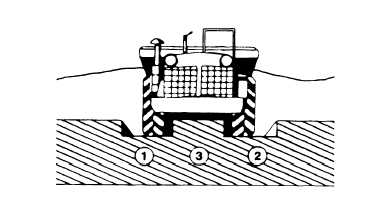has been loaded, scrape up a little dirt that will push the
object back further into the bowl.
To unload the object, shift the ejector from forward
to reverse several times to move the object around so it
will fall out. After the object has been unloaded, turn
the tractor sharply so the scraper clears the unloaded
object.
NOTE: Use extreme care when handling large
objects. Oversize objects, such as large rocks, can cause
damage by denting, bending, or straining parts. Damage
may also be done by accidental collision with large rocks
during ordinary digging.
PRODUCTION TECHNIQUES
Scraper production techniques are used to achieve
the most amount of work with the scrapers assigned.
These techniques are as follows.
Figure 10-44.-Straddle loading.
Downhill Loading
Downhill loading uses the force of gravity on the
scraper to get larger loads in less time. The added force
of gravity is 20 pounds per gross ton of weight per 1
percent of downhill grade. The downhill pull adds more
material per load, and the added material weight
increases the total gravitational pull.
Straddle Loading
Straddle loading gains time on every third trip
because the center strip loads with less resistance than
a full cut. After the first scraper has made a cut, the
second scraper should make a parallel cut and leave a 4-
to 5-foot-wide island between the two cuts, as shown in
figure 10-44. The third scraper can straddle this island
of material to achieve a fast, less resistance load.
Back-track Loading
Back-track loading is the method where the cut is
fairly short and loading in both directions is impractical.
As shown in figure 10-45, too much time is spent back
tracking and maneuvering the push cat for the next load.
When the cut is wide enough, other methods should be
tried.
Shuttle Loading
Shuttle loading is used for short cuts where it is
possible to load in both directions, as shown in figure
10-46. The push cat pushes one scraper in one direction,
then turns and push loads a second scraper in the
opposite direction.
Figure 10-45.-Back-track loading.
10-24










